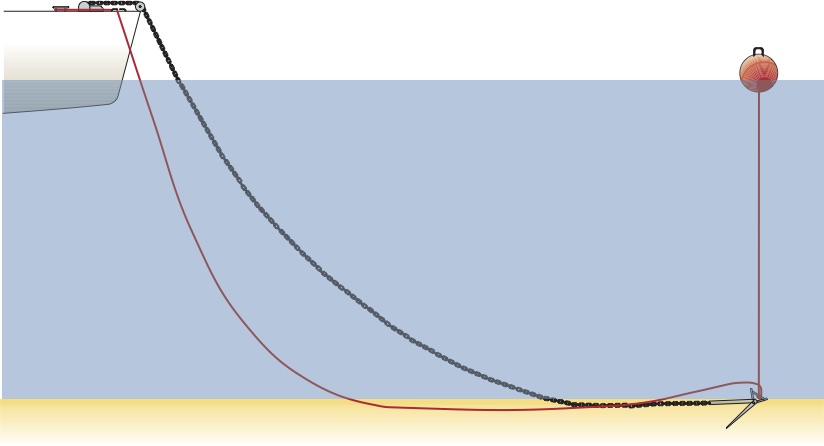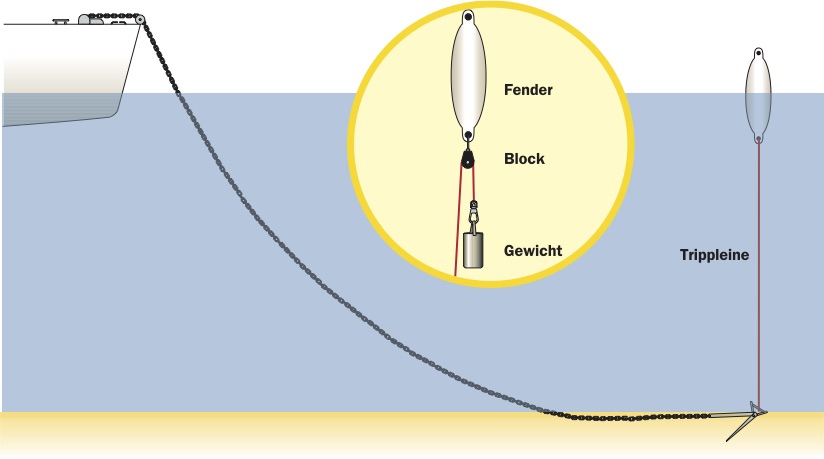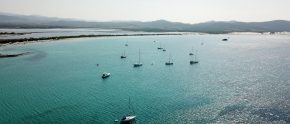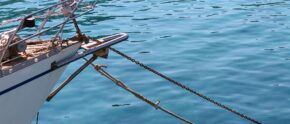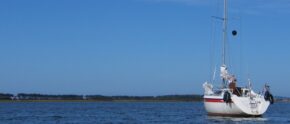Anchor maneuver
The retraction of the anchor is done in five steps – always nice and slow, so that the flukes can grip and are not pulled over the bottom.
Anchoring - step by step
- At the moment when the ship stops moving through the water, the helmsman gives the command: “Drop anchor”. The crew at the capstan releases the brake and lets the anchor rush out until it reaches the bottom. She then stops further probing and signals this by a previously agreed hand signal.
- Now the helmsman puts the lever back to slow, and as soon as the boat starts moving through the water again, the crew at the capstan shifts along evenly, but only as much as the ship “fetches”.
- While the ship slowly makes speed over the sternpost, the helmsman continuously calls out the length, for example: “ten meters are through, fifteen meters”. If the ship is to be on 30 meters of chain, the helmsman now disengages and gives the command at 30 meters: “Tight!”
Tip: With the fall of the anchor, do not let too much chain (line) rush out. It will otherwise lay over the anchor and there is a risk that a bay will get caught on its cross, preventing it from digging in.
- While the brake of the windlass is applied, the ship gently jerks into the anchor with the remaining speed. Once it has taken hold, the stem locks: The stem, which is more or less at right angles to the direction of pull, swings in the direction of the anchor.
- Now the helmsman briefly returns full until the stem has swung toward the anchor. At the same time, the crew on the forecastle puts their hand on the chain (line) as soon as it comes stiff. If the base harness slips, this can be clearly felt by vibration.
Tip: If the anchor does not grip, the stern will no longer turn in gusts or freshening winds, but will remain at an angle to the direction of pull of the chain. In addition, the anchor chain or line vibrates.
How much chain should you give?
The angle of pull of modern yacht anchors should not exceed eight degrees, so that it can withstand high wind pressure and does not break out during the sway. With a chain length corresponding to approximately seven times the anchor depth, this direction of pull is usually achieved. In permanently calm weather conditions, even five or only three times the length of the water depth is sufficient – especially if the swoj circle must be kept limited.
Leash or chain?
Clearly, a long and heavy anchor chain has every advantage over a line with a chain leader. Due to its own weight, it forms a bay under water even in fresh wind, which prevents the straining jamming in the swell and keeps the direction of pull on the anchor shaft largely parallel to the bottom. The heavier a chain, the more favorable these properties are and the later the ship will jerk.
Anchor shading
If it’s really stormy or you want to play it safe, it helps to tie two anchors. This involves shackling the secondary anchor to the front of the main anchor. When anchoring, first lower it by hand before following with the main anchor, driving moderately over the stern. Reeled in with due caution, anchors shaded in this way hold reliably even on difficult anchoring ground.
Anchoring in tidal waters
In tidal waters, there is no way around a second one, as a single anchor could be torn from the bottom if the current capsizes. Therefore, the ship should be moored with a second anchor. In case of rising current, main anchor is best deployed against the current, let out about half of the chain length and then drive the anchor into the bottom. Only now is full chain length put in and the secondary anchor deployed in the opposite direction from which the ebb stream will come. If the current capsizes, the ship turns into the secondary anchor. At the latest now you should drive this into the ground.
Deploy second anchor
Whether you should set a second anchor in strong winds and difficult conditions is still a matter of debate today. There are arguments both for and against. The only consensus is that the anchors should then be deployed at an angle of about 30 degrees to ensure optimum hold. However, the second anchor should definitely be deployed if the swoj circle is limited.
Anchor buoy
In case of great anchor depths or suspicion of rotten ground, always anchor with anchor buoy or caution line. Thus, the position of the anchor with a buoy always remains in view and the anchor can usually be slipped on the triple line quite reliably against the direction of pull. The same applies to the sorghum line.
The buoy has the disadvantage that it can easily end up in a screw in today’s traffic in anchor bays; the argument against the care line is that charter vessels do not always have one with the necessary length. Always make sure that the tether is longer than the attached chain, otherwise the line will pull the anchor out of the bottom! Nevertheless, if the worst comes to the worst, the safety line and anchor buoy will keep the boat and crew out of trouble.
